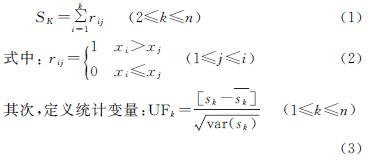资助项目:国家重点研发计划项目(2017YFC0404304); 青海省科技厅重大专项项目(2019-SF-A12); 青海省自然科学资助项目(2018-ZJ-903)
第一作者:赵美亮(1995—),男,山东临沂人,硕士研究生,研究方向为地表环境过程。E-mail:zhaomeiliang2014@163.com 通信作者:曹广超(1971—),男,山东苍山人,教授,博士生导师,主要从事青藏高原地区环境变化与地理信息系统应用研究。E-mail:caoguangchao@126.com
(1.青海师范大学 地理科学学院, 西宁 810008; 2.青海省自然地理与环境过程重点实验室, 西宁 810008; 3.青藏高原地表过程与生态保育教育部重点实验室, 西宁 810008; 4.青海省人民政府—北京师范大学 高原科学与可持续发展研究院, 西宁 810008; 5.德州学院 资源环境与规划学院, 山东 德州 253000)
(1.School of Geographical Science, Qinghai Normal University, Xining 810008, China; 2.Qinghai Province Key Laboratory of Physical Geography and Environmental Process, Xining 810008, China; 3.MOE Key Laboratory of Tibetan Plateau Land Surface Processes and Ecological Conservation, Xining 810008, China; 4.Academy of Plateau Science and Sustainability People's Government of Qinghai Province & Beijing Normal University, Xining 810008, China; 5.College of Resources, Environment and Planning, Dezhou University, Dezhou, Shandong 253023, China)
近年来,气候变化吸引了全球的普遍关注,成为国际科学研究的热点。第五次发布的IPCC报告指出地球表面的平均温度自1880—2012年大约升温0.85℃,中国同期气温上升约0.65℃[1]。气候变化通过影响陆面水文循环的过程使区域水资源在时空分布发生变化,进而对地表水资源产生重要影响[2-3]。因此,国内外众多学者从不同的角度持续关注气候变化与河川径流之间的关系[4-5]。王珂等人通过对澜沧江源区气候和径流的研究发现,降水量是影响年径流量的主控因素,而冬季和初春季节,气温升高加剧研究区内冰雪的消融,进而导致流域径流的增加[4]。孙栋元等人通过对疏勒河干流径流的变化特征研究指出,5—9月份径流量占全年的50%以上,径流年内分配极不均匀[6]。张雪琪等人对叶尔羌河流域的气候变化及径流响应分析发现,径流量与湿季气温呈正相关,与湿季平均风速、相对湿度呈负相关,干季的降水量与上游径流呈正相关关系[7]。李云武等人通过对祁连山八宝河流域的气候和径流研究发现,干季径流量较小,主要受气温上升、冻土退化的影响,降水量则是导致湿季径流量变化的主要原因[8]。
大通河是黄河的二级支流,发源于祁连山南坡沙杲林那穆吉木岭,河流落差大,水资源丰富,是青海省东北部和甘肃西部重要的水源地,在青海、甘肃两省社会和生态中具有十分重要的地位[9-13]。近年来随着跨流域调水及水利水电站等工程的开放建设,造成河流流量不断下降、水质恶化等一系列的生态环境问题。黄维东等[14]研究表明大通河流域水资源开发导致水文过程及生态环境恶化。张晓晓等[15]对大通河径流量变化特征研究发现大通河流域年径流在1950—2005年呈微弱减少趋势,并指出未来一段时间内径流仍然会呈现减少趋势。刘赛艳等[16]对大通河上游径流量研究发现气温升高和人类活动共同导致了径流量的减少。前人对大通河的研究多集中在源头或流域径流变化特征[9,12]及流域水资源开发引起的水文生态环境等方面[11,14-17],而围绕径流对气候变化响应角度的研究相对较少。因此,本文采取趋势分析、MK突变检验及小波分析等研究方法对流域内具有代表性的尕日得、青石嘴及享堂水文站1956—2016年径流数据和附近7个气象站点的气温、降水气象数据进行定量分析气候变化特征,探讨气候变化背景下径流的演变规律,研究结果为该区域的水资源管理及今后相关研究提供科学参考。
大通河流域(36°30'—38°25'N,98°30'—103°15'E)位于青藏高原东北部,北抵祁连山脉,南临大通山,是黄河的二级支流。大通河全长554 km,发源于祁连山南坡沙杲林那穆吉木岭,自西北向东南流经青海省和甘肃省两省的9个县,最后由民和县境内注入湟水河。大通河径流补给来源以降水为主。流域内1956—2016年多年平均气温约1.95℃,多年平均降水约380 mm,植被类型以林地、草地和高山灌丛草甸等为主。根据流域地形地貌特征,以尕日得、青石嘴和享堂水文站将流域划分为上、中、下游。
本文选用大通河流域尕日得、青石嘴和享堂水文站1956—2016年逐月径流数据,数据来源于青海省水文与水资源局; 选取大通河流域及其附近地区7个气象站同期气候数据,来源于中国气象数据网(http:∥data.cma.cn/)。所有数据经过极值和一致性检验。站点分布见图1。
1.2.1 Mann-Kendall突变检验 采用Mann-Kendall突变检验方法(下称M-K检验)分析气候及径流要素的突变特征,M-K方法是一种广泛用于气候水文分析的非参数统计检验方法,其主要优势是样本不需要服从正态分布[18-20]。
首先,对于含有n个样本量的时间序列x,构造一秩序列:

给出显著性水平0.05,得到Ua两条临界值线为±1.96。若正向序列UF>0,表明序列呈明显的上升趋势,反之,呈下降趋势。当超出Ua临界值线时,趋势显著。正向序列UF与逆向序列UB在置信区间内的交点是突变开始的时间[18]。本文中根据MK突变检验曲线和累积距平曲线对突变点进行综合判断。
1.2.2 小波分析 小波分析是目前在气候、水文学中广泛应用的一种时频分析方法[21],它可以根据小波基的变换反映气候及径流要素在时间序列的周期震荡,揭示其变化趋势[22]。表达式为[23]:

式中:π,e为常数; Fb,Fc分别表示频带宽度系数和wavelet的中心频率。
小波方差var是对时间尺度上小波系数的平方值进行积分,即[23]:

小波方差能直观的反映信号在时间尺度的分布情况,可用于确定某一现象的震荡的主周期,小波方差图体现出信号在时间尺度上的分布情况。因此,信号中主要时间尺度周期可由小波方差图检验得到[23]。
1.2.3 相关分析 相关系数是用来衡量两个要素之间密切程度的统计量。其公式为[24-26]:

式中:r为两个变量x与y的相关系数,其取值介于[-1,1]; n为样本量; xi,yi分别代表第i个序列值。当r>0时,表明两变量呈正相关; 反之,为负相关。给定显著性水平α,若|r|>rα。表明相关是显著的,否则是不显著的。
(1)气温:1956—2016年大通河流域平均气温为1.95℃,最低气温出现在1967年的0.75℃,最高气温出现在2016年的3.27℃,极差达到2.52℃。大通河流域多年平均气温变化倾向率为0.22℃/10 a(p<0.01)。在1956—1985年平均气温低于多年平均气温,在1986—1996年平均气温波动剧烈,1997—2016年超过多年平均气温,以0.34℃/10 a(p<0.01)的速度上升,升温趋势明显。
(2)降水:1956—2016年大通河流域多年平均降水量为379.96 mm,最低降水量出现在1962年,低至237.06 mm,最高降水量出现在2014年,高达520.41 mm,极差达到283.35 mm。大通河流域多年降水变化倾向率为26.78 mm/10 a(p<0.01)。其在1981年以前(除1958年、1961年、1964年、1967年外)低于多年平均值,1981—2016年(除1982年、1984年、1987年、1990年、1991年、2001年、2002年外)基本处于多年平均值以上。
(1)气温:大通河流域多年平均气温在研究时段内均发生由低温向高温的突变(图3A)。平均气温1999年突变前后分别为1.7℃和2.58℃,突变后上升了0.88℃; 通过分析UF曲线可知,在1960—1972年、1973—1989年UF<0,气温处于下降状态; 1956—1959年、1990—2016年UF>0,气温处于增加状态,并且在2000年以后超过信度曲线,增温显著。
(2)降水:大通河流域降水在研究时段内发生显著突变(图3B)。降水在1982年突变前后分别为327.22 mm和421.84 mm,突变后增加了94.62 mm。通过分析UF曲线可知,在1962—1973年UF<0,降水处于下降趋势; 1974—2016年UF>0,降水逐年增加,在1983年超过信度曲线,增加趋势显著。
(1)气温:根据气温小波分析结果(图4A)可知,1956—2016年大通河流域平均气温存在6 a,13 a及22 a尺度的周期变化,结合小波方差图可知,22 a尺度的周期变化占据主周期,1956—2016年共经历了5个正相位,分别为1956—1961年、1970—1976年、1985—1991年、1999—2006年、2014—2016年; 4个负相位、分别为1962—1969年、1977—1984年、1992—1998年,2007—2013年。此外,13 a尺度的副周期也在整个研究时段内均有体现。
(2)降水:根据降水小波分析结果(图4B)可知,1956—2016年大通河流域降水存在7 a和20 a尺度的周期变化。结合小波方差图可知,20 a尺度的变化是主周期,在整个研究时段内均有体现,其中,1956—1961年、1969—1973年、1983—1989年、1999—2004年、2012—2016年对应其5个正相位; 1962—1968年、1974—1982年、1990—1998年、2005—2011年对应4个负相位。7 a尺度的副周期变化在1956—1975年和1985—2014年比较明显。
2.2.1 年内变化特征 大通河多年月平均径流量呈现出不均匀的分布状态(图5)。其中尕日得、青石嘴和享堂站均在7月份径流量达到最大,分别占年径流量的25.63%,21.88%和19.24%; 在2月份达到最小,分别占年径流量的0.79%,0.88%和1.77%。年内径流量主要集中分布于5—10月,尕日得、青石嘴和享堂站6个月的径流量分别占其年径流量89.56%,87.33%和81.97%。
(1)径流变化趋势特征。1956—2016年大通河尕日得、青石嘴和享堂3个水文站多年平均径流量分别为8.53亿m3,16.39亿m3,27.52亿m3。其中,尕日得站年均径流量最大值出现在1989年的16.28亿m3,最小值出现在1973年的3.87亿m3,极差为12.41亿m3; 青石嘴站年均径流量最大值出现在1989年的29.3亿m3,最小值出现在1979年的8.64亿m3,极差为20.66亿m3; 享堂站年均径流量最大值出现在1989年的50.19亿m3,最小值出现在2015年的19.95亿m3,极差为30.24亿m3。由图6可知,除享堂站径流量呈现出下降趋势外(倾向率为-0.87亿m3/10 a(p<0.05)),尕日得和青石嘴站均呈现出一定的上升趋势,其上升速率分别为0.1亿m3/10 a,0.3亿m3/10 a。分析得到大通河上游、中游的尕日得和青石嘴站径流量呈增加趋势,这得益于近年来降水的增加及温度升高引起的冰雪融水消融,下游的享堂站受人类活动的影响(跨流域调水及下垫面的改变)径流量呈现下降趋势,这与董军等[9]关于大通河的研究结论基本一致,但其变化速率与之不同,主要是本文所选用的站点及研究时段不同导致的。气候因素一直影响大通河径流变化,但在一定的条件下,人类活动因素反而占据主导地位,人类活动与气候变化对大通河径流影响的具体细节仍需进一步工作。
(2)突变分析。运用M-K检验法对大通河1956—2016年径流量进行突变分析(图7),可以看出:尕日得站的UF与UB曲线在置信区间内存在多个交点,通过对累积距平和变化趋势进行分析后发现,尕日得径流量在2010年前后发生突变,突变前平均径流量为8.37亿m3,突变后平均径流量为9.98亿m3,突变后较突变前增加了1.61亿m3。通过分析其UF变化曲线可知,尕日得站在1956—1977年UF曲线波动剧烈,在1978—1987年和1994—2011年UF<0,径流量下降; 在2012—2016年UF>0,年径流量上升。根据青石嘴站M-K检验曲线、累积距平曲线及趋势特征综合分析判定其突变发生于2001年,突变前平均径流量为15.83亿m3,突变后平均径流量为18.13亿m3,突变后较突变前增加了2.3亿m3。通过分析其UF变化曲线可知,青石嘴站在1956—1959年、1964—1969年和2007—2016年UF>0,年径流量上升,但未超过信度曲线,增加趋势不显著; 1960—1963年、1977年、2006年UF<0,年径流量下降; 1970—1976年波动起伏剧烈。享堂站UF,UB曲线在置信区间内相交于2000年,结合累积距平曲线及其径流变化趋势特征认定2000年为享堂站的突变点,突变前平均径流量为28.59亿m3,突变后平均径流量为24.75亿m3,突变后较突变前减少了3.84亿m3。通过分析其UF变化曲线可知,享堂站UF曲线在1956—1976年波动起伏剧烈,1988—1995年UF>0,年径流量上升,1977—1987年和1996—2016年UF<0,径流量呈现出明显的下降趋势,其中2014—2016年超过信度曲线,下降趋势显著。
(3)周期变化特征。以大通河尕日得、青石嘴和享堂水文站1956—2016年径流量数据为基础,基于Morlet复小波函数对其年际变化特征进行分析并通过小波方差检验,小波分析结果见图8。
大通河尕日得水文站年净流量存在13 a和22 a尺度的周期震荡,经小波方差检验发现,22 a尺度的周期震荡是其第一主周期,在整个研究时段内经历了4个“丰—枯”转换期; 13 a尺度的周期变化在20世纪90年代以前表现较为强烈,研究时段内经历了6个“丰—枯”转换期。青石嘴水文站存在6 a,10 a和22 a尺度的周期震荡,22 a尺度是其第一主周期,共经历了4个“丰—枯”转换期,在10 a尺度上经历了8个“丰—枯”转换期,在6 a尺度上波动不明显。享堂水文站存在5 a,9 a和22 a尺度的周期变化,经小波方差检验22 a是其第一主周期,在整个研究时段内均有体现,而5 a的周期震荡出现在1970年以前,1970年以后这种周期震荡逐渐被9 a左右的周期震荡所取代。
通过上述分析可知,大通河3个水文站均存在22 a尺度的主周期变化,在此周期内,均经历了4个“丰—枯”交替循环过程。其次,3个水文站中,尕日得水文站的周期变化与气温的周期变化呈现出较好的关系,说明其可能受气温的影响较大; 另外青石嘴和享堂站的周期变化较为复杂,存在多尺度的周期震荡,这可能受其他补给方式及水资源开发利用的影响。
由表1可知,尕日得站除平均最高气温外,与其他气候要素呈正相关关系,其中与降水量相关系数最大,为0.395(p<0.01); 青石嘴站与尕日得站相关系数趋同,除平均最高气温外,与其他气候要素呈现出正相关关系,其中与降水量相关系数最大,为0.5(p<0.01),其次为平均最低气温0.385(p<0.01); 享堂站由于跨流域调水等人类活动的影响,径流变化的影响因素较为复杂,与降水量相关系数为0.301(p<0.05),与其他气象要素均为负相关关系。综上可知,大通河3个水文站径流量与降水的相关性较好,这表明降水是大通河径流的主要补给方式,气温通过影响冰雪融水和蒸散发来作用径流量。
此外,刘赛艳等[12]研究认为自20世纪90年代以来,在全球气候变暖的大背景下,大通河河源区雪线的不断上移甚至消失导致了径流量的显著减少; 说明温度对径流变化减小的作用一方面体现在影响冰川积雪的储量来作用径流量,另一方面则是通过影响蒸发作用进而减少径流量,但就其在径流变化中所贡献的程度仍需进一步研究。
2.3.2 人为因素的影响分析 人为因素对大通河流域径流的影响主要来自于两方面,一是跨流域调水引起径流量下降。流域内目前已建成跨流域调水工程3处,分别为1995年“引大入秦”工程,设计引水量4.43亿m3; 2003年“引硫济金”工程,设计引水量0.4亿m3; 2016年“引大济湟”一期工程,设计引水量3.5亿m3。随着生产、生活用水的增加及社会经济的发展,人们对大通河的取水量势必会增加,这也将导致大通河径流量逐年减少。二是流域地表覆被变化也会对径流产生一定的影响,朱丽蓉等人[27]对干旱区的昌化江径流研究发现,大规模经济作物的种植、大型水利工程建设和土壤侵蚀造成的下垫面变化间接导致了昌化江径流量下降; 代晓颖等人[28]通过对秦淮河流域的研究发现随着城市化进程的发展,1987—2013年流域内建设用地大幅度增加,植被覆盖度呈减少趋势,使得其调节径流的功能减弱,洪涝风险增加。总体上来看,大通河流域人类活动对径流的影响主要体现在跨流域调水工程和地表覆被变化两方面。根据相关研究可知[13],大通河流域自20世纪90年代以来,土地利用类型以草地和林地为主,没有发生大的变化,因此地表覆被变化对径流的影响作用较弱,引起大通河径流变化的主要人为因素是跨流域调水工程。
(1)1956—2016年大通河流域气候呈现暖湿化趋势,气温变化速率为0.22℃/10 a(p<0.01),降水变化速率为26.78 mm/10 a(p<0.01); 气温、降水分别在1999年、1982年发生变暖、增加性突变; 且两者小波主周期分别为22 a,20 a。
(2)大通河流域年内径流量呈现出不均匀的分布状态,尕日得、青石嘴和享堂3个水文站在汛期(5—10月)的径流量分别占其年径流量的89.56%,87.33%和81.97%。1956—2016年,大通河尕日得和青石嘴站的径流量以0.1亿m3/10 a,0.3亿m3/10 a上升,享堂站径流量以-0.87亿m3/10 a(p<0.05)的速率下降; 且尕日得、青石嘴和享堂三站分别在2010年、2001年、2000年发生突变,除享堂站外,其余两站突变后径流量均增加; 大通河3个水文站均存在22 a尺度的主周期变化,且周期内均经历了4个“丰—枯”交替循环。
(3)大通河3个水文站径流量与降水量均呈显著的正相关关系,降水是其主要补给来源; 与平均最高气温呈现出负相关关系; 尕日得和青石嘴站与平均气温、平均最低气温呈现出正相关关系。这表明径流变化除受气候变化的影响外,还受人类活动等因素的影响。由于尕日得和青石嘴站处于河流中上游,人为因素干扰较小,气候变化是其径流的主要影响因素。一方面气温升高导致的冰雪融水补给径流,另一方面可能存在温度升高加快河流的蒸发导致径流减小的影响。下游的享堂站则由于跨流域调水等人类活动的影响,径流变化较为复杂。